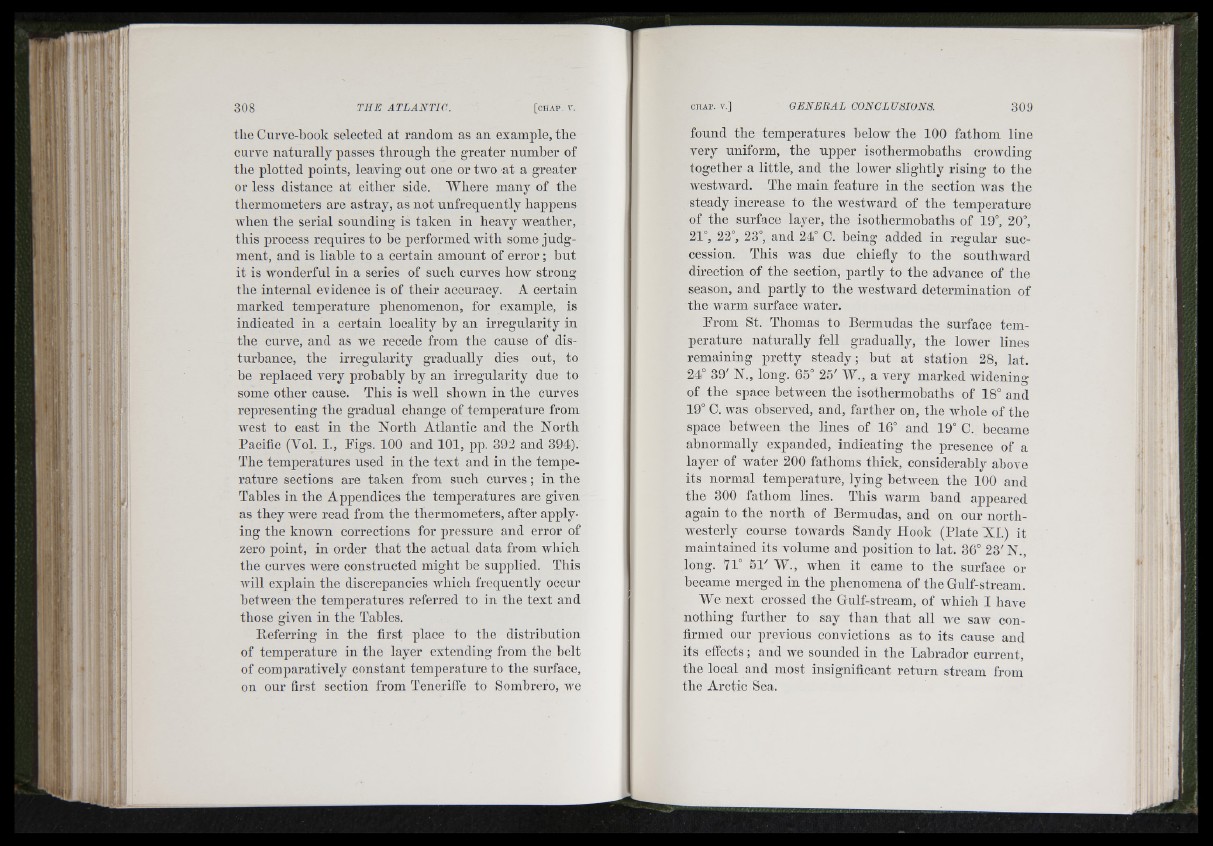
the Curve-book selected at random as an example, the
curve naturally passes through the greater number of
the plotted points, leaving out one or two at a greater
or less distance at either side. Where many of the
thermometers are astray, as not unfrequently happens
Avhen the serial sounding is taken in heavy weather,
this process requires to be performed witb some judgment,
and is liable to a certain amount of error ; but
it is wonderful in a series of such curves how strong
the internal evidence is of their accuracy. A certain
marked temperatnre phenomenon, for example, is
indicated in a certain locality hy an irregularity in
the curve, and as we recede from the cause of disturbance,
the irregularity gradually dies out, to
be replaced very probably by an irregularity due to
some other cause. This is Avell shown in the curves
representing the gradual change of temperature from
Avest to east in the North Atlantic and the North
Pacific (Vol. I., Pigs. 100 and 101, pp. 392 and 394).
The temperatures used in the text and in the temperature
sections are taken from such curves ; in the
Tables in the Appendices the temperatures are given
as they Avere read from the thermometers, after applying
the known corrections for pressure and error of
zero point, in order that the actual data from which
the curves Avere constructed might he supplied. This
AA'ill explain the discrepancies Avhich frequently occur
hetAveen the temperatures referred to in the text and
those given in the Tables.
Ileferring in the first place to the distrihution
of temperature in the layer extending from the belt
of comparatively constant temperatnre to the surface,
on onr first section from Teneriife to Sombrero, we
found the temperatures below the 100 fathom line
very uniform, the upper isothermohaths croAvding
together a little, and the lower slightly rising to the
westAvard. The main feature in the section Avas the
steady increase to the westAvard of the temperature
of the surface layer, the isothermohaths of 19°, 20°,
21°, 22°, 23°, and 24° C. being added in regular succession.
This was due chiefiy to the southward
direction of the section, partly to the advance of the
season, and partly to the westAvard determination of
the Avarm surface AA'ater.
From St. Thomas to Bermudas the surface temperature
naturally fell gradually, the lower lines
remaining pretty steady; hut at station 28, lat.
24° 39' N., long. 65° 25' W., a very marked Avidening
of the space between the isothermohaths of 18° and
19° C. was observed, and, farther on, the Avhole of the
space betAveen the lines of 16° and 19° C. became
abnormally expanded, indicating tbe presence of a
layer of Avater 200 fathoms thick, considerably above
its normal temperature, lying betAveen tbe 100 and
tbe 300 fatbom lines. Tbis warm band appeared
again to tbe north of Bermudas, and on our northwesterly
course toAvards Sandy Hook (Plate XL) it
maintained its volume and position to lat. 36° 2 3 'N.,
long. 71° 51' W., when it came to the surface or
became merged in the phenomena of the Gulf-stream.
We next crossed the Gulf-stream, of which I have
nothing further to say than that all Ave saw confirmed
onr previous convictions as to its cause and
its effects; and we sounded in the Labrador current,
the local and most insignificant return stream from
the Arctic Sea.